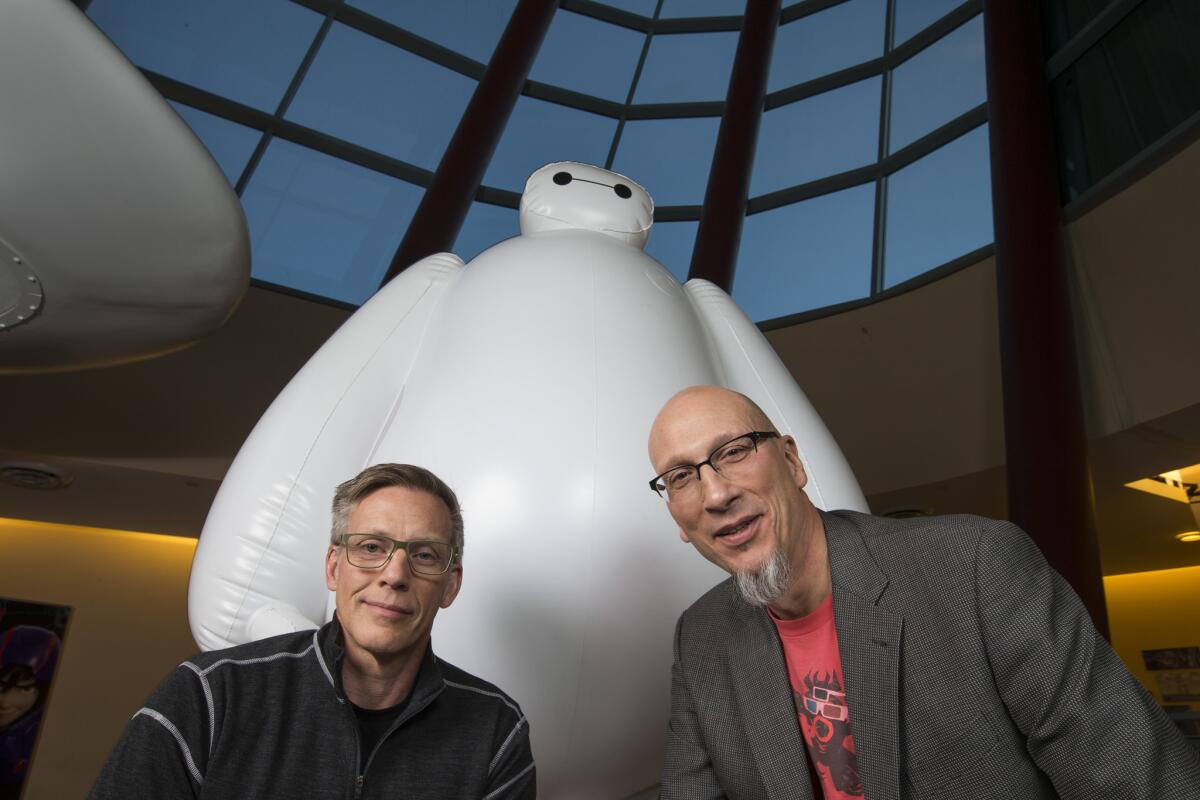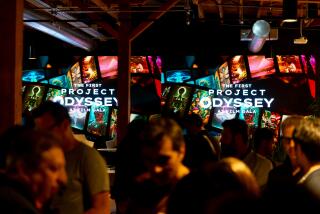Software behind ‘Big Hero 6’ pushes envelope on computer animation

- Share via
“Big Hero 6” has been a critical and commercial hit for Walt Disney Animation Studios, scoring an Oscar nomination and taking in more than $500 million at the box office.
But the more important number may be the 39,000 hours Disney Animation spent developing the computer program that made the movie possible.
The software, called Hyperion, simulates the physics of light, which can make animated films more lifelike or give them an otherworldly look.
FULL COVERAGE: Oscars 2015
It’s the latest salvo in a technological arms race among animation houses. One of Disney’s rivals, DreamWorks Animation, had a research and development group of about 120 people as of last year — among them nearly a dozen former employees of NASA’s Jet Propulsion Laboratory in Pasadena.
Disney Animation’s sister company, Pixar, has long been a trailblazer, producing the first feature-length computer-animated film, 1995’s “Toy Story.”
But Hyperion could transform animation.
“It’s a major step for them,” said Dan Sarto, co-founder and publisher of Animation World Network. “They are only as good as the tools they allow their artists to use.”
Computer-animated films are big business: In most years, a handful rank among the top 10 U.S. box-office hits. They can also generate toys, clothes and other products that will produce big profits.
Disney Animation’s “Frozen” grossed more than $1 billion and has bolstered profits for several business units of the studio’s parent, Burbank-based Walt Disney Co.
Such massive hits are rare. But in Hyperion, Disney Animation has a powerful new tool.
The software — named for the Silver Lake street that was home to the first headquarters of Walt Disney Studios — was created to solve a problem. Disney Animation executives felt that none of the existing programs available to the company was advanced enough to create the world that the “Big Hero 6” filmmakers had envisioned.
The movie, released in November and directed by Don Hall and Chris Williams, centers on a robot (Baymax) and a robotics prodigy (Hiro) who form a superhero group and take on a masked villain in the futuristic city of San Fransokyo. The metropolis, a mash-up of San Francisco and Tokyo, is situated on a shimmering bay and teems with towering skyscrapers and pulsing neon lights.
“We wanted to make sure we could get the air and light of San Francisco,” said “Big Hero 6” producer Roy Conli. “I lived there years ago as a student, and I just remember the skies.”
The film’s animation drew praise from reviewers, and several aerial sequences — including a memorable twilight flying scene — are filled with eye-catchingly realistic uses of light. Without Hyperion, the movie would not have looked as lush and could not have delivered on the vision of the directors, said Disney Animation Chief Technology Officer Andy Hendrickson.
There could be a big reward on Sunday for the painstaking effort it took to create Hyperion. “Big Hero 6,” which cost an estimated $165 million to produce, is among the favorites to win the Academy Award for best animated feature. Most Oscar prognosticators believe it is in a two-movie race with DreamWorks’ “How to Train Your Dragon 2.”
But no matter what transpires Sunday, Hyperion will be utilized for years to come. The software is now being used by Disney Animation for its forthcoming movie “Zootopia,” which will be released in March 2016. It also was deployed for “Frozen Fever,” a short that features the characters of “Frozen” and debuts in March; and “Feast,” the Oscar-nominated short that premiered alongside “Big Hero 6.”
Before Hyperion, the process of rendering light was tedious because each ray of light’s trajectory had to be individually tracked. A single frame of animation could contain several light sources, and each ray of light could bounce off multiple surfaces, making the calculation of those individual pathways a computational challenge.
“When you shoot [lights] into scenes, they can split into thousands of rays,” Hendrickson said. “Does it reflect right back if it came off a mirror? Does it scatter? Does it pick up the color of the object? You end up running out of computing power.”
Development of Hyperion, which took about 2 1/2 years, was jump-started by an idea from software engineer Brent Burley.
Burley posited that organizing large groups of light rays into bundles would allow a computer system to more efficiently handle calculations of their trajectories. By doing this, a film could feature more lighting sources and add nuance to their depiction. He presented his theory to Disney Animation executives in November 2011, and they were encouraged.
The company decided to put Burley’s ideas to work. An initial team of four developers working on the project eventually swelled to 12 people. Disney Animation did not bring in outside programmers to work on Hyperion, instead handling the job completely in-house. (Disney Animation declined to provide an estimate of the cost to develop it.)
The decision to create Hyperion was not without risk. Programmers were still coding the software when “Big Hero 6” went into production, and they completed it only in July 2014, a few months before the movie went into postproduction. Had the software not performed as Disney Animation hoped, production of “Big Hero 6” could have been imperiled.
“This was a big risk,” Sarto said. “But it will pay off for them. A tool like this allows them to spend more time art directing how the film is going to look.”
To render “Big Hero 6,” Disney Animation built a supercomputer that is roughly the same size as those operated by the Center for Computational Sciences at Japan’s University of Tsukuba and the National Super Computer Center in Hunan, China, according to website Top500.org, which ranks the largest supercomputers in the world.
“They actually run quite complex physics models,” said Wilfred Pinfold, a super computing expert. “If you actually run a physics model, you can sort of judge the math and … things are much more realistic.”
Still, all of Disney Animation’s computer firepower needed to be monitored, in case a glitch in Hyperion gummed up the rendering of “Big Hero 6.” Disney employees could track the system from an unlikely place: the company’s coffee bar.
The second-floor break room — known internally as the Caffeine Patch — was outfitted with a flat-screen monitor that displayed a graphic showing the supercomputer’s up-to-the-second performance.
Some of the “Big Hero 6” filmmakers, including director of lighting Adolph Lusinsky, struggled to avert their eyes whenever they went to the Caffeine Patch to fuel up, captivated by the green lights that meant things were operating normally. Some were even able to monitor the computer system remotely on weekends via a website.
“We held to our schedule and I trusted that Andy and the team were going to get it done,” Conli said.
Twitter: @DanielNMiller
More to Read
From the Oscars to the Emmys.
Get the Envelope newsletter for exclusive awards season coverage, behind-the-scenes stories from the Envelope podcast and columnist Glenn Whipp’s must-read analysis.
You may occasionally receive promotional content from the Los Angeles Times.








